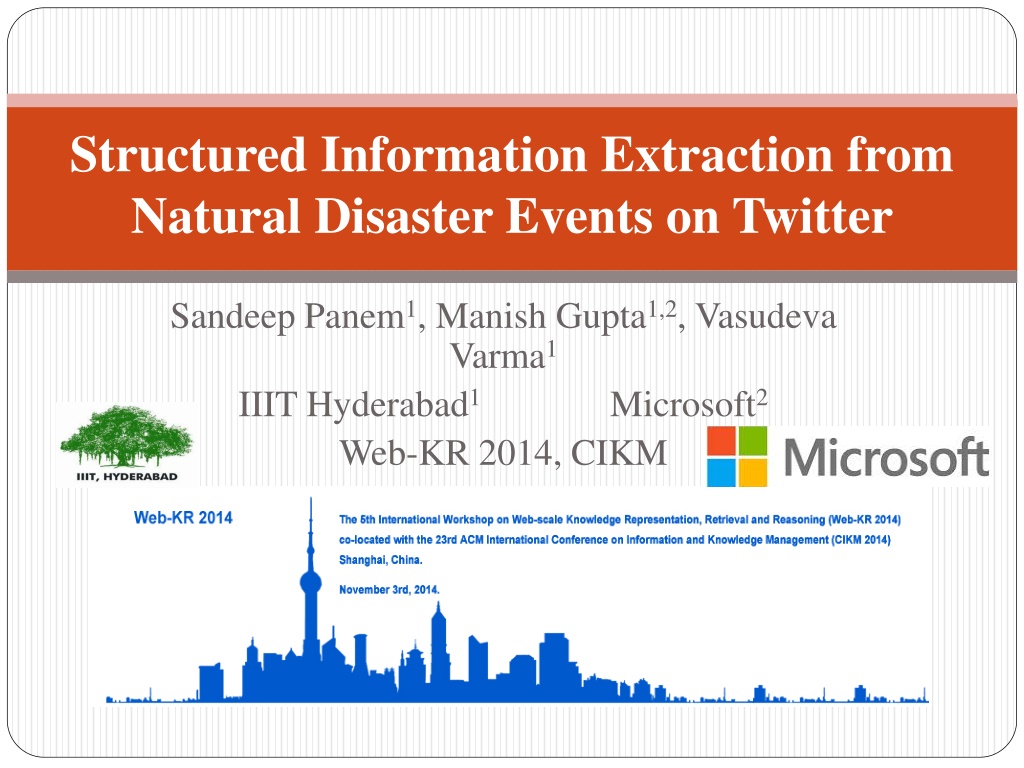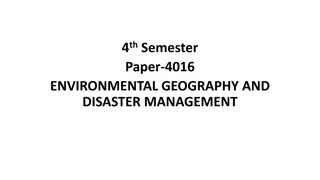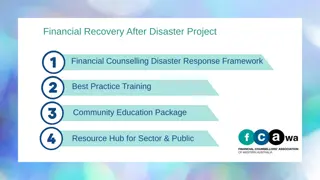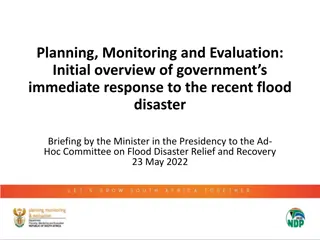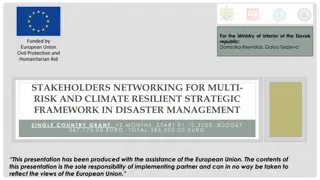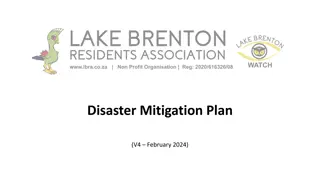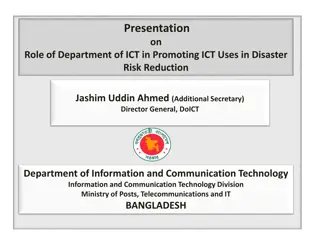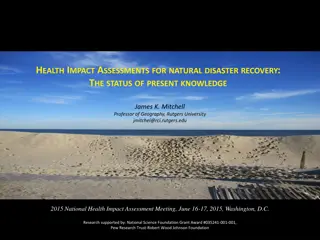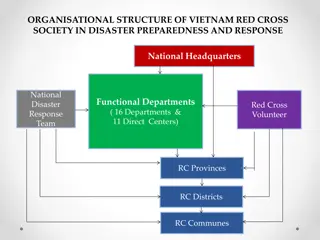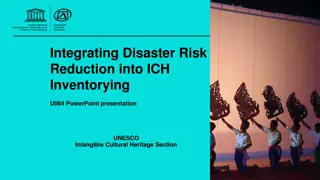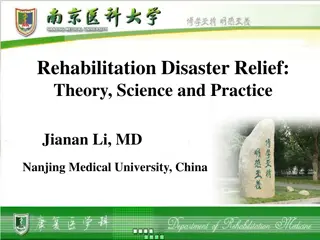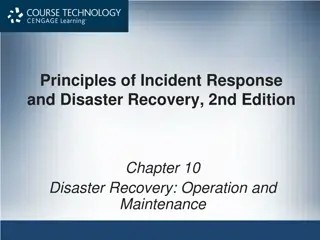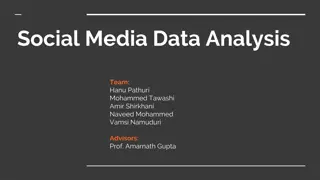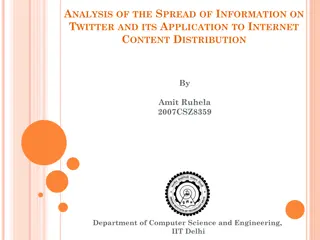Natural Disaster Events on Twitter
This study focuses on extracting structured event infoboxes from Twitter related to natural calamity events such as wildfire in California. The challenge lies in dealing with noisy and ambiguous tweets, lack of defined schema, and difficulty in extracting attribute-value pairs from unstructured text. By leveraging Twitter data, the aim is to provide users with updated and fine-grained information in a structured format, reducing the need for multiple clicks to access relevant details.
Download Presentation

Please find below an Image/Link to download the presentation.
The content on the website is provided AS IS for your information and personal use only. It may not be sold, licensed, or shared on other websites without obtaining consent from the author.If you encounter any issues during the download, it is possible that the publisher has removed the file from their server.
You are allowed to download the files provided on this website for personal or commercial use, subject to the condition that they are used lawfully. All files are the property of their respective owners.
The content on the website is provided AS IS for your information and personal use only. It may not be sold, licensed, or shared on other websites without obtaining consent from the author.
E N D
Presentation Transcript
Structured Information Extraction from Natural Disaster Events on Twitter Sandeep Panem1, Manish Gupta1,2, Vasudeva Varma1 IIIT Hyderabad1 Web-KR 2014, CIKM Microsoft2
Tweets Related to Disaster Events California Wildfire 2014 Wildfire Evacuation Orders Lifted For Most In Southern California Three people are arrested in connection with a California wildfire that has already destroyed 1,700 acres (688 ha) northeast of Los Angeles. Weary Crews Prepare for Long Wildfire Season in California -The last of tens of... http://j.mp/1sGU4r4 #SanDiegoCounty #SanMarcos #CAFire @AshHelp Sask. town evacuated ahead of #wild#fire threat http://dlvr.it/5mpWhb #smokedamage http://ow.ly/cE1QH As San Diego wildfires dwindle, state braces for more - Entering new wildfire era, California broadcasts an old... http://j.mp/1o4tYyn Southern California wildfire is 78% contained
Motivation As soon as natural disaster events happen, users are eager to know more about them. Search engines provide a ten blue links interface. Relevance of results for such queries can be significantly improved if users are shown a structured summary of the fresh events related to such queries. Twitter is a great source that can be exploited for obtaining such fine-grained structured information for fresh natural disaster events.
Challenges Tweets are noisy and ambiguous. There is no well defined schema for various types of natural disaster events. It is not trivial to extract attribute-value pairs and facts from unstructured text. It is difficult to find good mappings between extracted attributes and attributes in the event schema.
Contributions Extraction of structured event Infoboxes from Twitter for natural calamity events. Reduces the number of user clicks to get the relevant information and also help users get updated with more fine grained attribute-level information. The proposed system is the first to focus on extraction of structured event Infoboxes from Twitter for natural calamity events.
Stanford Dependencies Primer Arizona struggles to contain blaze: Conflagration engulfs 110,000 acres... http://bit.ly/RpMYv4. root(ROOT-0, struggles-2); nsubj(struggles-2, Arizona- 1);aux(contain-4, to-3); xcomp(struggles-2, contain-4); dobj(contain-4, blaze-5); nsubj(engulfs-8, Conflagration-7); parataxis(struggles-2, engulfs-8); num(acres-10, 110,000-9); dobj(engulfs-8, acres-10); prep_of(acres-10, land-12) Dependencies root, nsubj, dobj, pobj, nn, prep_*, num, number, amod, dep
Numeric Attribute-Value Extraction Na ve approaches like considering the neighboring words close to numeric literals as attribute names do not always work. Attribute Value Death toll rises to 123 in Mexico following Tropical Storm Ingrid. We can observe that 123 cannot be linked to the previous word or the next word. It needs to be linked to the phrase which actually describes it by understanding the relation.
Special Cases of Attribute-Value Mentions Handling of Special Cases of Attribute-Value Mentions. Numeric Values are mentioned side-by-side: Example: #USGS M 1.9 - 4km N of Hydesville, California: Time 2014-07-03 02:31:00 UTC 2014-07-02 19:31:00 -07:00 at ep.. . Attribute-Value pairs mentioned in a Sequence: Example: Mag: 3 - Depth: 116 km - UTC 8:07 AM - Tarapaca, Chile - EMSC . Repeated occurrences of ( numeric , noun ) pairs helps us detect such cases and identify the attribute and its value appropriately. Here attributes Mag , Depth , UTC are extracted along with the values 3 , 116km , 8:07 AM respectively.
Extracting Attribute-Value Pairs using Dependencies The subject and the object are extracted from the dependent parts of the nsubj and dobj dependencies respectively. The (governor, dependent) pair of every num dependency provides an attribute-value pair. The (governor, dependent) pair of every nn dependency provides an attribute-value pair if the dependent contains digits. Combine a few dependencies to extract complete attribute names. Use nsubj , nn , prep_* to expand the attribute name and the corresponding subject.
Textual Attribute-Value Extraction Compared to numeric attribute-value pairs, it is more challenging to mine textual attribute-value pairs due to the lack of any numeric clues. Attribute Value For example, consider the tweet: Hurricane Sandy Value Attribute cancels many flights at Orlando Airport.
Textual Attribute-Value Extraction Three ways to obtain attribute-value pairs A central attribute-value pair related to the subject of the tweet (CentralAV) Attribute-value pairs related to the root word of the tweet (RootAV) Attribute-value pairs connected to preposition dependencies (PrepAV) RootAv root word is the attribute. dobj, pobj and amod dependencies help obtain values. CentralAV subject and the verb using nsubj Use nn dependency to extract the CentralAV pair PrepAV Obtain the prepositional pairs Use nn dependencies to enhance the prepositional pairs Use some of these prepositional pairs to obtain an attribute-value pair
Fact Triplet Extraction A fact triplet consists of three main parts: Subject, Predicate and the Object. Subject Volvo Ocean Race set for raft of changes to boats, teams Objects Object Predicate and route in bid to appeasesailors and sponsors via @Telgraph http://soc.li/AenbU9M
Relation Extraction Algorithm Obtain the subjects and objects using various dependencies. Obtain the root word and its index. If there is no subject in the tweet, use the root word to form a subject. Use various dependencies to expand the subjects and objects to get their complete forms. Subjects and objects are then matched using the verbs that appear with them in the dependencies. These verbs form the predicates, and are expanded using the prepositional modifiers. Finally matching expanded (subject, predicate, object) are returned as fact triplets.
Generation of Event Schemas Extract attribute names from Wikipedia infoboxes. Large mismatch between the Wikipedia Infobox attribute names and the attributes extracted from Twitter Manual generation of event schemas with guidance from Wikipedia Infoboxes For each event type Minimum and maximum value an attribute of that type can hold Data type for each attribute of each event type. integer, float, string, date, time. Units for each event attribute. mph , km/h for wind_speed A set of synonyms. For example, total_cost, total_loss, money_loss are synonyms for total_economic_impact
Populating Event Schemas Assign the most frequent value to each attribute. Map the attribute-value pair to a schema attribute. For each extracted attribute-value pair (a, v) and each schema attribute s, compute a match score based on does v lie within the range of attribute s, does v has the same units as s, similarity between units of s and subject of a, similarity between units of s and object of a, similarity between units of a and value of a, similarity between s and subject of a, similarity between s and object of a, similarity between s and a.
Dataset 5 natural disaster event types: earthquakes, hurricanes (or typhoons), floods, wildfires and landslides. For each event type, we crawled tweets of 3 5 recent events listed as follows. Earthquakes: Chile Earthquake, Visayas Earthquake, Mexico Earthquake, Solomon Earthquake, Vizag Earthquake. Hurricanes: Hurricane Sandy, Hurricane Amanda, Hurricane Ingrid Manuel, Typhoon Haiyan, Typhoon Phailin. Floods: Balkan Floods, Serbia Floods, US Colorado Floods,Uttarakhand Floods. Wildfires: CaliforniaWildfire, AlaskaWildfire, ArizonaWildfire Landslides: Washington Landslide, Zambales Landslide, Bolivia Landslide We obtained related tweets using the Twitter search API. On an average the dataset consists of ~3000 tweets per event.
Average Precision (P), Recall (R), and F1 for the three Variations Avg. Precision Avg. Recall Avg. F1 Only Tweets 0.851 0.385 0.516 Only Web-links 0.891 0.293 0.429 Tweets + Web-links 0.874 0.460 0.595
Chile Earthquake 2014 Case Study Attribute areas_affected distance_miles magnitude mw (moment magnitude) mb (body-wave magnitude) ml (local magnitude) death_toll people_evacuated missing_people date duration time tsunami_warning Value chile iquique antofagasta 6.6 5.0 5.9 4.7 4.0 1,655 300 40k 2014-05-05 1 minute (P1M) 05:00 3
Chile Earthquake 2014 Case Study Attribute direction@e direction@ne direction@n direction@se direction@sw direction@s direction@nw depth Value 98km 47km 73km 34km 67km 20.1km 19km 10.0 Note the variety of attributes that can be extracted from tweets. Showing such structured information for the query Chile earthquake would surely be better than what popular search engines show today.
Temporal Analysis of Attribute-Value Pairs We performed temporal analysis regarding how the event schemas get populated and how the attribute-value pairs evolve over time. Observations People talk more about attributes like number of people died, magnitude, direction, number of people affected compared to other attributes. Usually technical attributes like the magnitude, depth of the epicenter, etc. appear first on Twitter. After some time, when field analysis gets done, people start tweeting about the damage. This is when we observe attributes like people affected, schools affected, people injured getting populated. Attribute values that appear in the beginning are not very trustworthy. Slowly over time the attribute values become stable. Some attributes are inherently temporal in nature. people_dead
Conclusions We studied the problem of extracting structured information for natural disaster events from Twitter. We proposed three novel algorithms for numeric attribute- value extraction, textual attribute-value extraction, and fact triplet extraction. We also proposed an algorithm to map the extracted attributes to a schema for the corresponding event type. Experiments on 58000 tweets for 20 events show the effectiveness of the proposed approach. Such a structured event summary can significantly improve the relevance of the displayed results by providing key information about the event to the user without any extra clicks.
References (1) F. Abel, I. Celik, G.-J. Houben, and P. Siehndel. Leveraging the Semantics of Tweets for Adaptive Faceted Search on Twitter. In International Semantic Web Conference, pages 1 17, 2011. E. Alfonseca, K. Filippova, J.-Y. Delort, and G. Garrido. Pattern Learning for Relation Extraction with a Hierarchical Topic Model. In Proc. of the 50th Annual Meeting of the Association for Computational Linguistics (ACL). E. Alfonseca, M. Pasca, and E. Robledo-Arnuncio. Acquisition of Instance Attributes via Labeled and Related Instances. In Proc. of the 33rd Intl. ACM SIGIR Conf. on Research and Development in Information Retrieval (SIGIR), pages 58 65. ACM, 2010. K. Bellare, P. P. Talukdar, G. Kumaran, F. Pereira, M. Liberman, A. McCallum, and M. Dredze. Lightly-Supervised Attribute Extraction. In Proc. of the Neural Information Processing Systems (NIPS) 2007 Workshop on Machine Learning for Web Search, 2007. A. X. Chang and C. D. Manning. SUTime: A Library for Recognizing and Normalizing Time Expressions. In Proc. of the 2012 Intl. Conf. on Language Resources and Evaluation (LREC), pages 3735 3740, 2012. M.-C. de Marneffe and C. D. Manning. The Stanford Typed Dependencies Representation. In Proc. of the COLING Workshop on Cross-Framework and Cross-Domain Parser Evaluation, pages 1 8, 2008 A. Fader, S. Soderland, and O. Etzioni. Identifying Relations for Open Information Extraction. In Proc. of the Conf. on Empirical Methods in Natural Language Processing (EMNLP), pages 1535 1545. Association for Computational Linguistics, 2011
References (2) K. Gimpel, N. Schneider, B. O Connor, D. Das, D. Mills, J. Eisenstein, M. Heilman, D. Yogatama, J. Flanigan, and N. A. Smith. Part-of-speech Tagging for Twitter: Annotation, Features, and Experiments. In Proc. of the 49th Annual Meeting of the Association for Computational Linguistics: Human Language Technologies (HLT), pages 42 47, 2011. M. Gupta, R. Li, and K. Chang. Tutorial: Towards a Social Media Analytics Platform: Event Detection and User Profiling for Microblogs. In Proc. of the 23rd Intl. Conf. on World Wide Web (WWW), 2014. T. Hua, F. Chen, L. Zhao, C.-T. Lu, and N. Ramakrishnan. STED: Semi-supervised Targeted-interest Event Detection in Twitter. In Proc. of the 19th ACM SIGKDD Intl. Conf. on Knowledge Discovery and Data Mining (KDD), pages 1466 1469, 2013. K. Kireyev, L. Palen, and K. Anderson. Applications of Topics Models to Analysis of Disaster-Related Twitter Data. In NIPS Workshop on Applications for Topic Models: Text and Beyond, Dec 2009. T. Lee, Z. Wang, H. Wang, and S. won Hwang. Attribute Extraction and Scoring: A Probabilistic Approach. In Proc. of the 2013 IEEE 29th Intl. Conf. on Data Engineering (ICDE), pages 194 205, 2013. P. L w. Natural Catastrophes in 2012 Dominated by U.S. Weather Extremes.http://www.worldwatch.org/natural- catastrophes-2012-dominated-us- eatherextremes- 0, 2013. A. Marcus, M. S. Bernstein, O. Badar, D. R. Karger, S. Madden, and R. C. Miller. Processing and Visualizing the Data in Tweets. ACM SIGMOD Record, 40(4):21 27, 2012. M. Mathioudakis and N. Koudas. Twittermonitor: Trend Detection over the Twitter Stream. In Proc. of the 2010 ACM SIGMOD Intl. Conf. on Management of Data (SIGMOD), pages 1155 1158, 2010. N. Nakashole, G. Weikum, and F. Suchanek. PATTY: A Taxonomy of Relational Patterns with Semantic Types. In Proc. of the 2012 Joint Conf. on Empirical Methods in Natural Language Processing and Computational Natural Language Learning (EMNLP-CoNLL), pages 1135 1145. Association for Computational Linguistics, 2012.
References (3) J. Reisinger and M. Pasca. Low-Cost Supervision for Multiple-Source Attribute Extraction. In Proc. of the 2009 Conf. on Intelligent Text Processing and Computational Linguistics (CICLing), pages 382 393, 2009. A. Ritter, O. Etzioni, S. Clark, et al. Open Domain Event Extraction from Twitter. In Proc. of the 18th ACM SIGKDD Intl. Conf. on Knowledge Discovery and Data Mining (KDD), pages 1104 1112, 2012. D. Rusu, L. Dali, B. Fortuna, M. Grobelnik, and D. Mladenic. Triplet Extraction From Sentences. In Proc. of the 10th Intl. Multiconf. Information Society - IS 2007 , volume A, pages 218 222, 2007. T. Sakaki, M. Okazaki, and Y. Matsuo. Earthquake Shakes Twitter Users: Real-Time Event Detection by Social Sensors. In Intl. World Wide Web Conference (WWW), pages 851 860, 2010. S. Sarawagi. Information Extraction. Foundations and Trends in Databases,1(3):261 377, 2008. K. Starbird, L. Palen, A. L. Hughes, and S. Vieweg. Chatter on the Red: What Hazards Threat Reveals about the Social Life of Microblogged Information. In Computer Supported Cooperative Work (CSCW), pages 241 250, 2010 S. Vieweg, A. L. Hughes, K. Starbird, and L. Palen. Microblogging During Two Natural Hazards Events: What Twitter may Contribute to Situational Awareness. In Intl. Conf. on Human Factors in Computing Systems (CHI), pages 1079 1088, 2010 Y. W. Wong, D. Widdows, T. Lokovic, and K. Nigam. Scalable Attribute-Value Extraction from Semi-structured Text. In Proc. of the 2009 IEEE Intl. Conf. on Data Mining (ICDM) Workshops, pages 302 307, 2009. F. Wu and D. S. Weld. Automatically Refining the Wikipedia Infobox Ontology. In Proc. of the 17th Intl. Conf. on World Wide Web (WWW), pages 635 644. ACM, 2008. J. Yang and J. Leskovec. Patterns of Temporal Variation in Online Media. In Proc. of the 4th ACM Intl. Conf. on Web Search and Data Mining (WSDM), pages 177 186. ACM, 2011.
